In this blog post, you will know the food and drinks of Laos, the Southeast Asian country that’s food scene is as diverse as its geography. Know the names of foods that you will come across in the menu cards of Laos’s restaurants, what are they made of and their accompanying alcoholic beverages including locally brewed, soft drinks, and fruit juices.
At the outset, you must know Laos’s food scene is an outcome of several national and international factors. For example, the residual influence of French reign can be seen in Laos’s cuisine as well as the architecture. This is evident of the availability of French bakery products but baked in Laos.
Next, Laos is a mountainous country and as a result, the food habits of those living in the hills have its own effects on the food and drinks of Laos.
Another interesting geographical factor that influences any country’s food scene is the flowing of the Mekong River through Laos. River fish, lobsters, and crabs are widely eaten throughout Laos.
The Buddhist cult and the presence of hundreds of Buddhist monks mean you can find Buddhist cuisine too.
Thai cuisine is predominantly available in Laos as the north of Thailand shares its border with the south of Laos.
Food and Drinks of Laos That You Must Know:
Now, let us move on to the names of Food and Drinks of Laos that you must know if you are contemplating a trip to this exciting Southeast Asian country.
-
Popular Food and Drinks of Laos: Larb
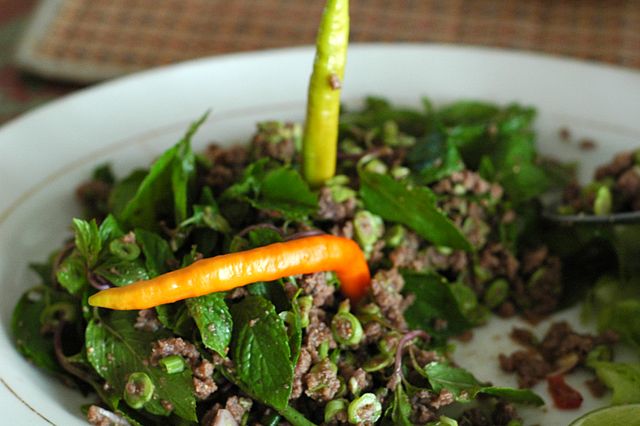
Ah, it looks appetizing to me; the presence of greens in any dish is a good sight. Larb is a popular Laotian food and is a beef salad. If you find fish replacing the hard beef, do not be surprised as sometimes you may find chunks of raw fish. I thought only the Japanese eat raw fish. Well, after all, Japan is not too far off from Loas-right?
-
Fish Food and Drinks of Laos: Ping Pa
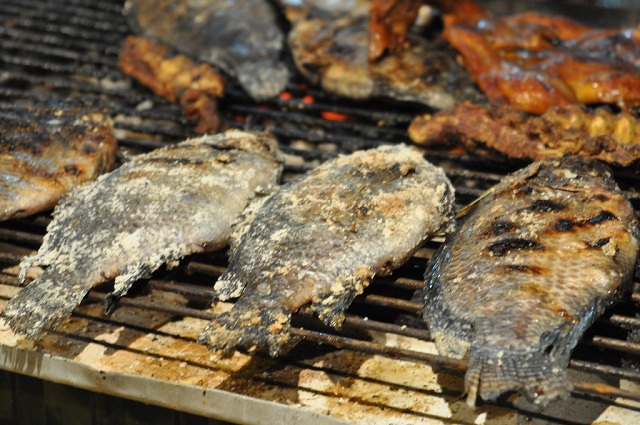
As you can make it, Ping Pa is nothing but grilled fish. This local Laotian cuisine must have originated on the Mekong River delta.
In Laotian cuisine, use of basil and various other indigenous herbs is quite common. To some extent, these delectable spices and herbs nullify the smell of meat. I think the word ‘ping’ means ‘grilled’.
-
Ping Gai
This is grilled chicken in Laos dining table.
-
Ping Seen
The Ping Seen is beef, grilled and marinated with spicy vegetables.
-
Ping Theen Gai
A unique Laotian food favorite is the feet of a chicken. It is rare that people prefer to eat chicken’s feet but it is common in Laos.
-
Rice Food and Drinks of Laos: Jok
Jok is eaten for breakfast in Thailand. It is a ubiquitous Thai street food that found its way into Laos also. Jok is a rice porridge (congee in India). It is not uncommon to toss a few chunks of fish in it and topped with finely cut onion.
-
Nam Khao
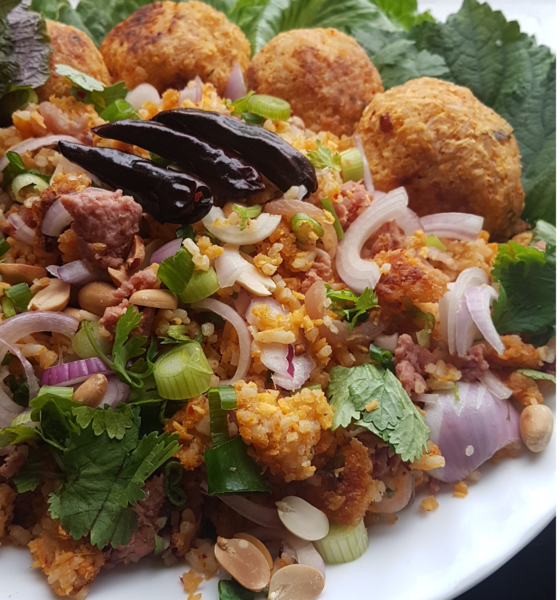
I am sure you might have eaten fried rice before. Well, Nam Khao, a popular food in Laos is almost the same as fried rice but only more crispy and the dish is rolled into a ball before mixed liberally with vegetables such as shallots and cilantro, pork sausage and finally lime juice squeezed fresh.
-
Som Moo
In Laos, Som Moo is a pork sausage.
-
Food and Drinks of Laos: Tam Maak Hoong
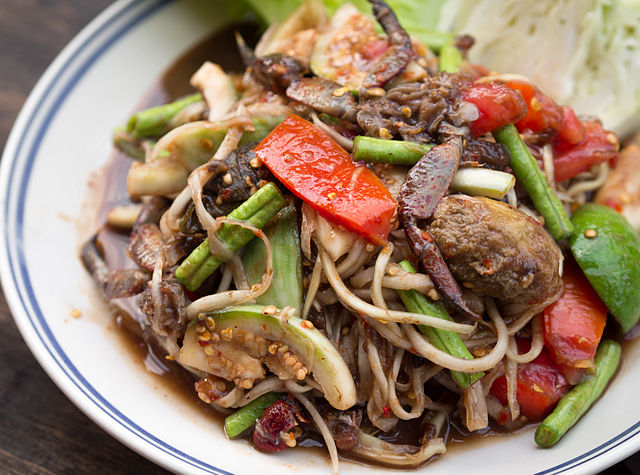
Tam Maak Hoong is meant you are eating a raw papaya salad.
Tam Maak Hoong
Of course, no one can eat green papaya-right? Well, this Laotian food is mixed with lime juice, salted crab meat, and hog plum fruit.
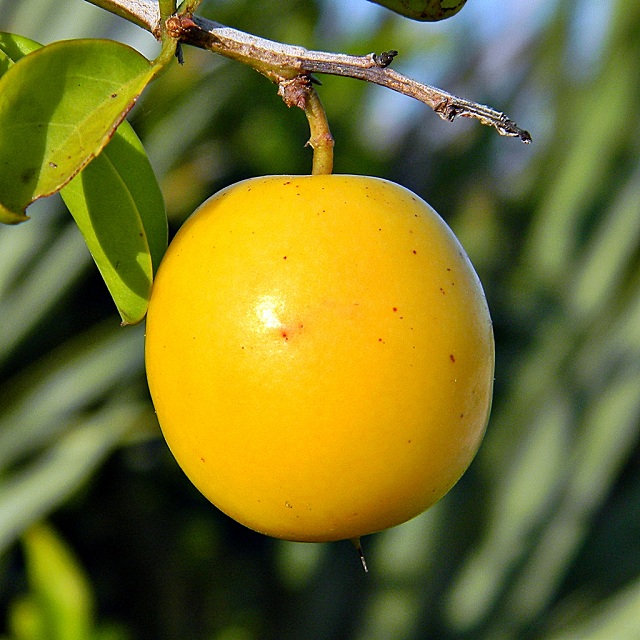
-
Ping Ped
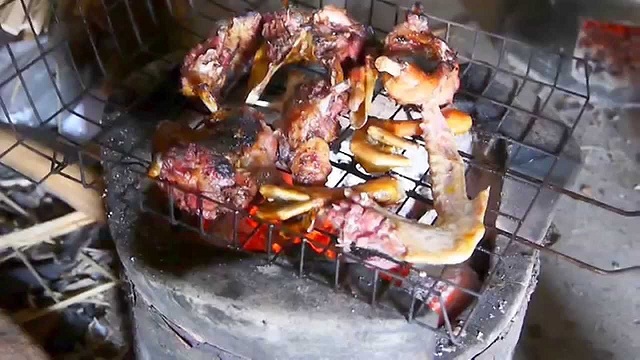
Yes, you guessed it right, mister! This Laotian food is some kind of grilled meat. Do you want to know which meat is used in Ping Ped? It is the succulent duck!
-
Seen Dat
An authentic food of Laos, it is barbequed meat or vegetables. Yes, more than one vegetable is used on the coal-fired stove. It may contain potato or yam (yam is more preferred over potato in Laos), capsicum, and tomato. Sometimes, cauliflower is also cooked in barbeque style in Vientiane, the capital of Laos.
The word ‘seen’ means ‘seared’ in Laos. I think it makes sense in this context as the Laotian food ‘Seen Dat’ is seared meat (usually beef or pork) cooked in barbeque method.
Seen Dat is heaped on a large plate and the entire Laotian family sits around the dish and share it with relish.
-
Khao Jee
If it is snack time in Laos, then, people from all walks of life reach out for this delicious Laotian sandwich- baguette sandwich in fact.
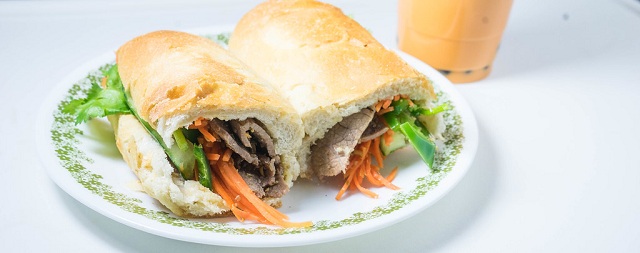
It looks more of a wrap or burger than a sandwich to me. Nevertheless, it is a favorite snack of people of Laos.
The ingredients of Khao Jee comprises:
- Sticky rice
- Pork chunks
- Cucumber
- Onion
- Cilantro
- Raw Papaya
You are given the choice of custom fillings that include avocado fruit, lemon grass herb, egg, or carrots! Interesting combinations of ingredients in this Laotian food-eh?
-
Sai Ua-aka Sai Oua
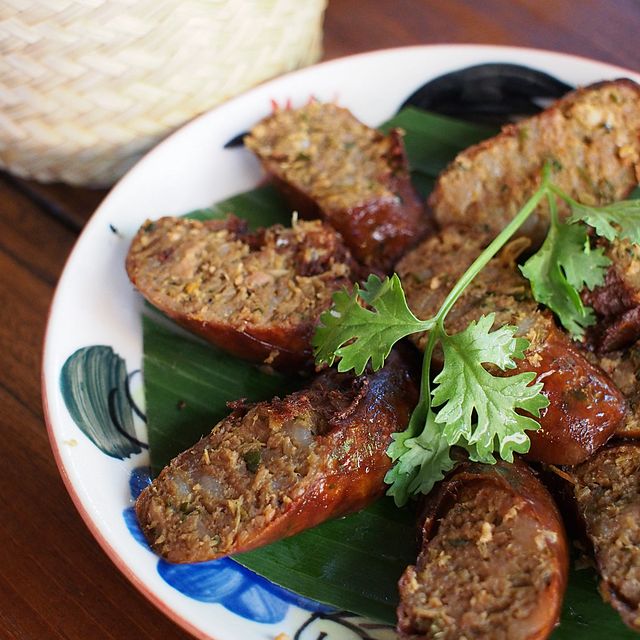
Yes, it is a meat dish. It is of course made of pork. This pork sausage must have originated from Thailand where culinary inventions continue to evolve and become world famous. Shallots and lemongrass are added as flavoring agents.
-
Khao Niew
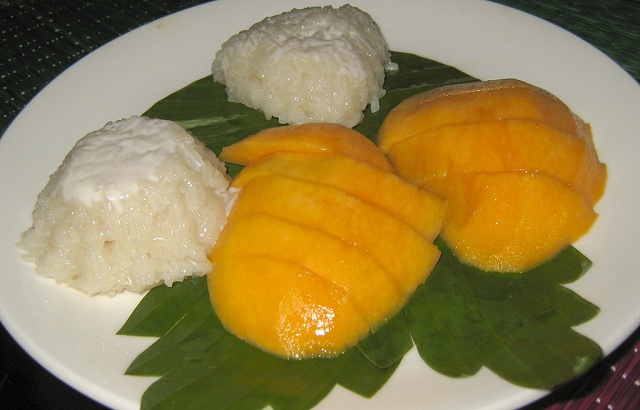
The image of Khao Niew above shows a plate of sticky rice placed on papaya leaves. The sticky rice is eaten with ripe mango fruit. Alternatively, you can even order any other fruit such as durian to accompany your plate of sticky rice.
Sticky rice is the staple of Laos and the people eat sticky rice several times day. Since the raw sticky rice contains low amylase and more sugar, the rice turns sticky when cooked on steam. The rice grains are opaque and is known as ‘glutinous’ rice but it contains no gluten of course.
In restaurants, when you order mango rice, don’t be taken aback when they bring a small basket of bamboo as the sticky rice is brought to your table in a bamboo basket only.
You then help yourself with the right quantity of sticky rice and your mango fruit slices.
Khao Niew is a desert, buddy!
-
Khao Nom Krok
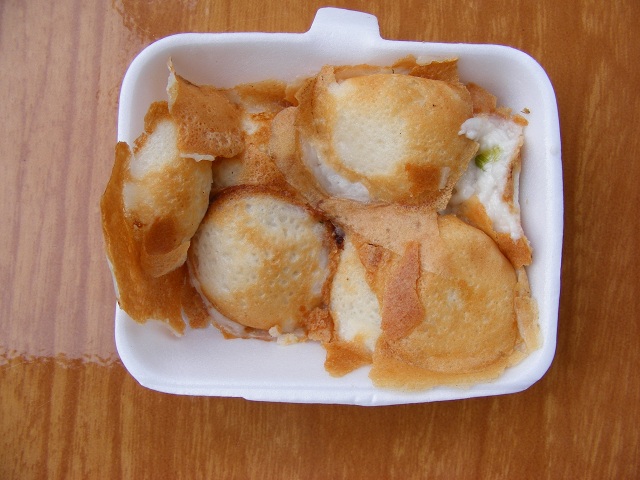
Kaho Nam Krok is originated from Thailand. It is actually a pancake and is found in street food stalls in Laotian streets. When I read about its ingredients and the way of cooking, I thought it is an Indian snack item called ‘paniyaram’.
Khao Nam Krok contains rice flour, coconut shreds or coconut milk, and sugar. The resulting batter is rather thick and is poured on cast iron moulds and shallow fried in coconut oil. The final product will have crusty coating outside but inside, it is spongy and delicious when you bite into it.
Laotian Drinks
Alcoholic drinks, Laos
- Beerlao- an alcoholic drink of Laos
This is a beer brewed in Laos. It is ubiquitous and surprisingly, Beerlao is made of rice! However, the fermenting agent ‘yeast’ is imported from Germany.
- Lao Lao
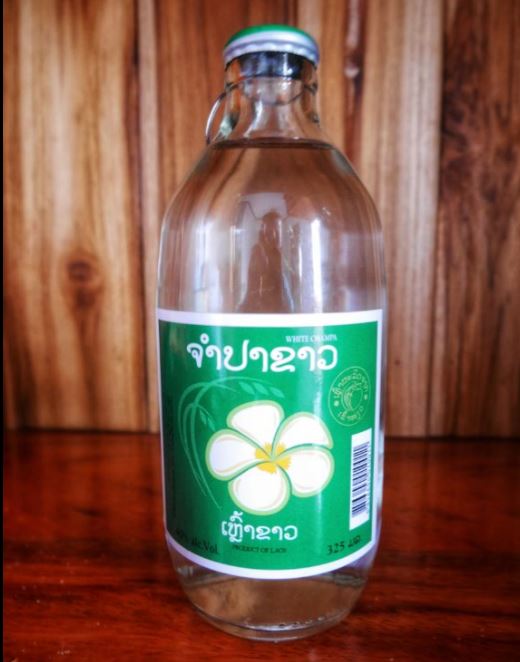
Please note that this Laotian alcoholic drink is a rice whiskey. It’s a popular drink in Laos and well patronized because of its local origin. Moreover, Lao Lao is very cheap and easily affordable by all class of people. This implies Lao Lao is a poor man’s drink in Laos.
- Lao-hai
Lao hai is the Laotian wine and drunk by all. This Laotian drink is made of rice. Since the rice wine is brewed in an earthen pot (hai), it is known as Lao Hai.
See how Lao Hai is drunk.
The rice wine is not poured into cups but drunk directly from the large clay pot using a straw.
Beverages of Laos
-
Paksong Coffee
This Laotian coffee is planted in Bolaven Plateau in Paksong and hence the name.
-
Other varieties of coffee in Laos.
Ask your tour guide that you want to taste some of the Laos special coffee varieties and with a glow on his face, he will guide you to a few roadside tea shops where you can taste the Laotian saffron coffee and Jhai coffee.
-
Saa – Tea from Loas
Unlike the tea that the Indians and Pakistanis drink, the tea in Laos is a green tea and is a favorite drink of Laotians. Do you know this green tea is given to you free in Laos?
So, which tea in Laos you have to pay for?
It is the black decoction of Saa that is priced. You have the option of drinking it as a black tea after adding sugar or you can also mix condensed milk in it.
-
Nam Oi
Nam Oi in Laos is sugarcane juice. You will find street vendors everywhere in Laotian streets crushing sugar cane and making fresh sugar cane juice.
Laos is a hot place and a glass of sugar cane juice can restore your energy lost due to heat.
-
Nam Mak Pow
Nam Mak Pow is coconut milk in Laos. It is a slightly thick beverage and sweet because cane sugar is mixed in it.
Local food accompaniments in Laos that you can buy and take it back to your home country:
- Padaek-a fish sauce that goes with just about every food item in Laos. You will begin to like it
- Food and drinks of Laos: Jeow Bong
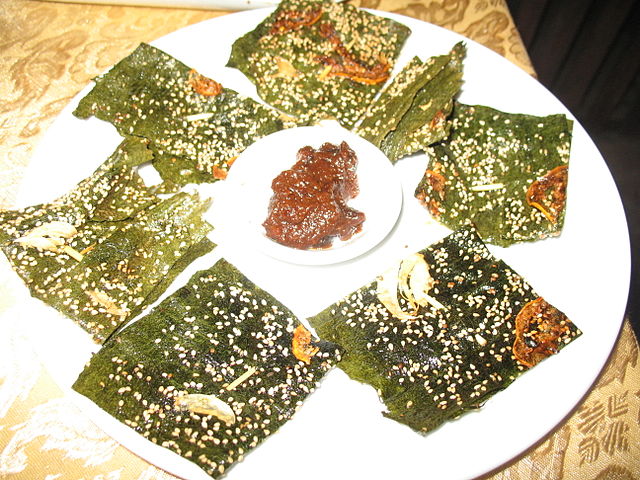
Do you know this Laotian food’s main ingredient is buffalo’s skin? Incredible! What a unique ingredient in a Laos’s food!
The taste of Jeow Bong is sweet and sour. In addition to the buffalo’s skin, this Laotian dish contains a rare herb called ‘galangal’. This rare spice when added with exclusive Laotian chilies, the resulting product (paste) is of unique taste in the dining tables of Laotian houses.
Jeow Bong is used as a chutney or a sauce. The ubiquitous sticky rice balls are dipped into Jeow Bong and eaten.
As the shelf life of Jeow Bong is long and is basically a chutney, you can buy it from the local shops. As later day innovation, Jeow Bong also contains garlic, small onions, tamarind, and fish sauce.
Food and Drinks of Laos: Desserts of Laos
Desserts are the favorites of all children. Though desserts are kept for eating as last course on a dinner table, children would be itching to reach for them at the beginning of the meal itself.
Let us know what Laos desserts scenario is:
-
Nam Van
Nam van is a fruit salad comprising seasonal local fruits that include, jack fruit and durian. I would not use these two strong smelling fruits in a fruit salad. They are to be eaten individually and in isolation too.
So, that’s all about the food and drinks of Laos that you should know before you embark upon the Southeast Asian country.


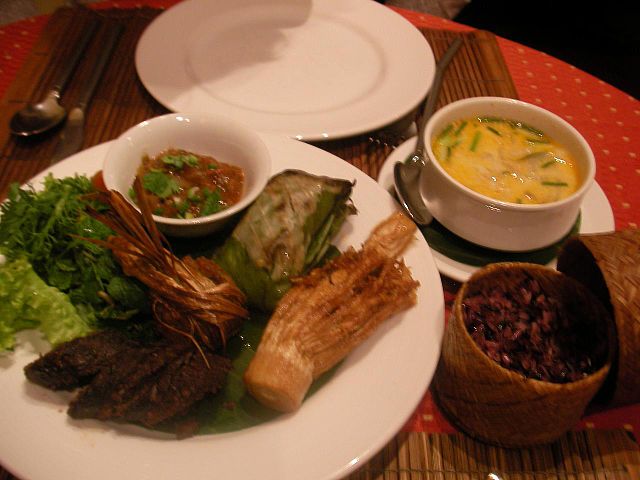
1 comment
Nice and mouth watering!
Comments are closed.